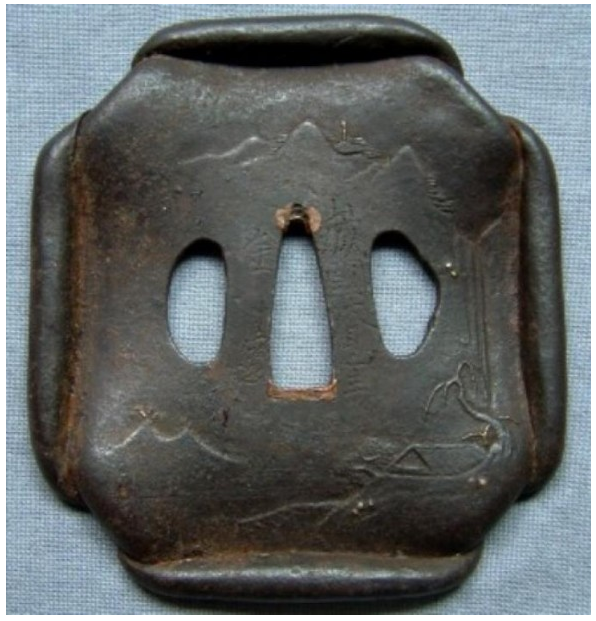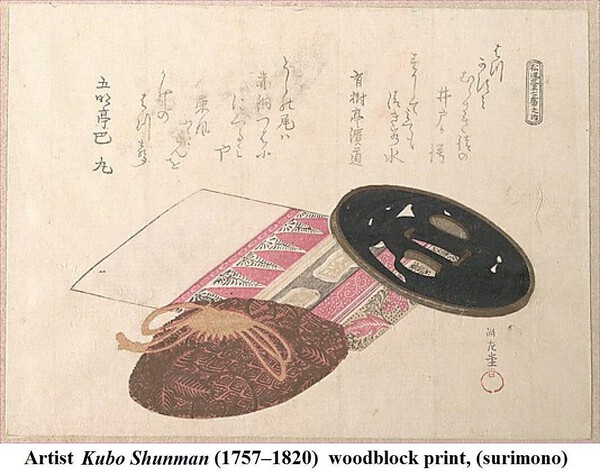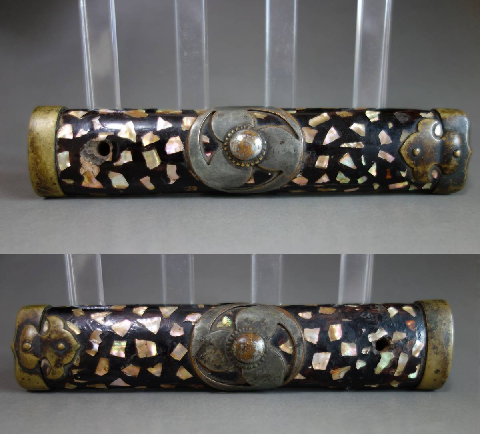-
Posts
3,699 -
Joined
-
Last visited
-
Days Won
100
Content Type
Profiles
Forums
Events
Store
Downloads
Gallery
Everything posted by Spartancrest
-
Are you sure it isn't spelled "Twerp" family? I believe that star was made by our old backyard blacksmith dj2hmyuc https://www.jauce.co...j2hmyuc?search=tsuba Fresh off the forge!
-
I concur, it is not a casting I have ever seen before. The real markers for me is the way the nakago-ana is cut and the rust damage where the tail meets the rim - that 'dimple' in his rear. It also has that look of "steel wool" being used to clean it? If you look carefully there is a groove at the bottom of the hitsu - identical spot - identical "cleaned" tsuba IMHO
-
Did the guard come from Ibaraki Prefecture by any chance? This seller on Jauce is well known for "reproductions" https://www.jauce.co...j2hmyuc?search=tsuba Though in this case the quality of yours looks better.
-
You can find the 'Kitsune' guard in the V&A on a mounted sword - I don't think they show the guard separately https://collections..../sword-scabbard-and/ "The sword's hand guard, the tsuba, is decorated with a design of a magic fox at moonlight using dark shibuichi, an alloy of copper and silver normally patinated to give a wide variety of colours." The guard might be shown somewhere amongst the 3,389 tsuba and fittings here https://collections....&page=1&page_size=50 My eyes were burning after the first thousand!
-
Tony does it have waves on the omote? A similar guard from the D.Z. Norton collection. This particular guard is something of a mystery as it is listed as being 'gifted' to the Cleveland Museum of Art in 1920 - but it fails to turn up in searches of that Museums collection now - where did it go?
-
Yes, but I took a pill and it seems to have settled -
-
Well I think these 12,14,16 etc. petal kiku are just not trying hard enough - one of mine has 32 petals so is that twice as good? Waka size 74 x 68 x 4 mm 100g - Impossible to tell its age but it has a very old feel to it. [The image is lightened, it is much darker in real life] The imperial Chrysanthemum is misleading as it shows 16 petals prominently but there are another 16 hidden at the back with just the tips showing. https://aminoapps.co...Mpoo0kKz7aL0NoLEmjDe
-
An image taken from L. Gonse, L'art Japonais, Paris I883 You can see the carver is wearing glasses while the sheet metal worker doesn't need them.
-
https://ukiyo-e.org/...-00043402-111129-F12 Japanese Parrot Art Parrots and other exotic birds were a favorite subject of shin hanga print designers. In many of the prints pictured, the birds are delicately perched atop a beautiful flowering branch. These compositions, more romantic than realistic, are typical of shin hanga kacho-e. A few prints, such as Kurumazaka by Hiroshi Yoshida, depict the birds in more natural poses. Ohara Koson (1877-1945) Cockatoo and Pomegranate, 1927 Ohara Koson (1877-1945)Cockatoo and Pomegranate Ohara Koson (1877-1945) A Pair of Macaws Ohara Koson (1877-1945) Cockatoo on Bar, 1927 Ohara Koson (1877-1945) Two White Cockatoos on a Red Bar Ohara Koson (1877-1945) Parrot on Flowering Plum Utagawa Toyokuni (1769 - 1825) Shoun Yamamoto (1870-1965) The View of the Four Seasons Kiyokata Kaburagi (1878-1973) Isoda Koryusai (1735-1790) Toraji Ishikawa (1875-1964) Blue Cockatoo, 1934 Shiro Kasamatsu (1898-1991) Cage Birds, 1957 Ito Sozan (1884-?) Parrot on Pomegranate, 1925 Ito Sozan (1884-?) Two Macaws in Tree, 1925 Hiroshi Yoshida (1876-1950) Kibatan Parrot, 1926 Hiroshi Yoshida (1876-1950) Obatan Parrot, 1926 Hiroshi Yoshida (1876-1950) Kurumazaka, 1926 Tsuruoka Kakunen (1892-1977) Parrot on Flowering Branch, 1940 Hodo Nishimura (active 1930s) Parrot on Magnolia, 1937 Hodo Nishimura (active 1930s) Cockatoo on Branch, 1938 Utagawa Hiroshige (1797-1858) Parrot on a Flowering Crabapple Branch, late 1830s https://www.panteek....pages/kns164-272.htm I can't say who designed and made the tsuba [magnificent] but the subject is not native to Japan.
-
Sir Elton John: ‘I collect for the beauty, not the value. I’m in awe of these things’ https://www.theguard...e-modern-radical-eye How is that for a quote! - taken completely out of context, but a nice sentiment to aspire to. On the other part of the serious discussion, would the said Samurai not replace the entire koshirae? A beautiful lacquer saya is bound to get damaged and would the tsuka for "town & court" be ideal for battle? Or could the samurai have a separate "battle sword" already mounted and ready to go? I have no idea how they managed to work it out, I guess it would depend on how much notification time they had?
-
Don't go breaking my heart - nothing wrong with "Kiki"
-
-
Bruno, not much of a meal with only a three legged frog.
-
A signed Jakushi which is very similar to Saga Kaneie work. https://www.facebook...&type=3&locale=en_GB https://bilbaomuseoa...f-ingles-2-55-mb.pdf http://mizusumashi.com/post-11668/ "Ironwork four-way folded large tsuba, Kaneie, stolen item." Any one seen this stolen guard? One of mine I picked up for about half the asking price several years after it appeared in a catalogue. A lot of these are described as being by Kaneie but I seriously doubt that Nobuie, Jakushi and Kaneie three BIG names all did this style and decorated them so similarly - they were far too busy doing twenty different styles all ascribed to them! This one still listed on ebay https://www.ebay.com/itm/404702540914 https://www.jauce.com/auction/e1096786988 An older auction that had a heap of possible makers lined up! Owari/Kanayama/Yagyu/Ono/Akasaka
-
Check this link out https://note.com/kat...5c-8877-fa9c150d001d English translation is available.
- 1 reply
-
- 2
-

-

-
I put a "flippant" snipe bid on a set of five Japanese books with the full expectation that I would easily be out bid - woke this morning to find I had won. Now my bid was for the 'princely' sum of 550 yen, however, what I ended paying was 220 yen, So what did the other bidders [3] see that caused them not to pay more than a rather miserable $1.55 USD ! Have I done my money? https://page.auction.../auction/k1118545073 or https://www.jauce.com/auction/k1118545073
-

A storage box for tsuba - that won't break the bank
Spartancrest replied to Spartancrest's topic in Tosogu
Me either! Post Christmas is only as long as the bargains last - then you 'ante-up'! [ante up (something) US informal. : To give money, often unwillingly ] https://dictionary.c...nary/english/ante-up -

A storage box for tsuba - that won't break the bank
Spartancrest replied to Spartancrest's topic in Tosogu
You might find them on-line? They are a Chinese company [of course!] Anko is a K-mart "brand" there are a few lookalikes but they have sectioned interiors which are not useful for tosogu. not as practical as the draw string version. https://www.temu.com...&refer_page_sn=10017 Stephen you can get a velvet lined one from within the US for considerably more money https://shoptiques.c...y-travel-case-velvet I will happily stick with my $9 versions -
I was having a look around our local K-mart and came across these today. https://www.kmart.co...ALw_wcB&gclsrc=aw.ds A nicely made round "suede" look case with a draw string cover - They easily fit a tsuba up to 82mm in diameter and offer great protection. The two clips under the lid could also be used for menuki. At $9 AU They are far cheaper than a Kiri box, of course not as traditional. Though from the images of some old Surimono, Kiri boxes were not the only way tsuba were stored. [Just a little 'post Christmas' shopping I bought out the local stock ]
-
I don't know if this belongs in tosogu or over on nihonto - not really either? I just came across this "Helmet breaker" https://www.jauce.com/auction/g1119004160 Now for something designed to give a hefty whack or designed to deflect one - this screams out to me to be rather designed to break at the first time it was used. Any comments on the structural integrity of such a "decorative" tool?
-
-
This is selling again https://www.jauce.com/auction/t1118726205 or https://buyee.jp/ite.../auction/t1118726205
-
https://en.wikipedia.org/wiki/Haliotis There are at least seven "abalone" species in and around Japan.
-
I just had a weird thought - [most of mine are weird] - What vibes would be given off, if by chance we place two [or more] rival samurai clans' tsuba side by side in a display or within the same close proximity in storage? [my guess is not much] but it is a thought that for some, the closest the two rivals would have been "together" before, might well have been when engaged in conflict and battle.












.thumb.jpg.335476b657966eacbe97363ad1bcd6bd.jpg)















